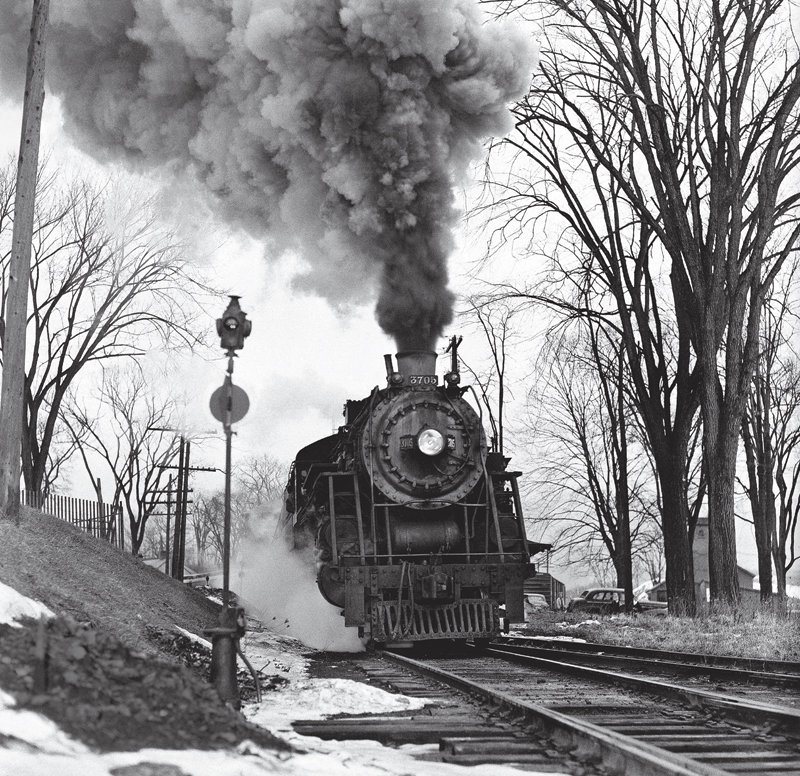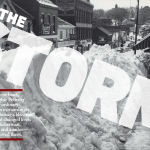New England Trains | Memories of the Railroad
SLIDE SHOW: Train Photos with Pinhole Camera by Brandon Dole I’ve carried two clear memories of trains with me from the years I spent growing up in Walpole, New Hampshire. In one of them, I’m 12 years old, crouched along a gravel embankment with a couple of boys from North Walpole, waiting for a northbound […]

Coffee By Design | Portland, Maine
Photo Credit : Katherine Keenan
Photo reprinted from The Call of Trains: Railroad Photographs by Jim Shaughnessy, with text by Jeff Brouws, copyright Jim Shaughnessy, with permission of the publisher, W.W. Norton & Co. Inc.
Photo Credit : Shaughnessy, Jim
I’ve carried two clear memories of trains with me from the years I spent growing up in Walpole, New Hampshire. In one of them, I’m 12 years old, crouched along a gravel embankment with a couple of boys from North Walpole, waiting for a northbound freight to come over the Bellows Falls trestle and flatten smooth a penny that we’ve laid on a track above us.
What we’re doing feels illicit, dangerous, charges the air. The train explodes across the trestle; the engine thunders; the wheels screech, metal grinding metal–the penny will end up thin and shiny and hot to the touch. But what I remember is the machinery–awesome and more terrifying than anything I’d ever seen so close.In the second memory, 10 years later, it’s November, nighttime. My hometown girlfriend and I have broken up, and I’ve driven her across the Connecticut River to catch the Amtrak Montrealer out of the little station at Bellows Falls. On my way back home, still not believing it could really be over, I hear the long train whistle over on the Vermont side, at Westminster. I glance across the black water and see the lights of the passenger cars streaming southward through the darkness, and then disappearing. And I suddenly know, with aching certainty: It’s over.
What interests me now is how clear and utterly different those two memories are–and how varied are the places that trains can hold in the imagination. For everyone from blues singers to model-railroad builders, trains have always meant something deeper than transportation. Editors at Trains magazine estimate that 175,000 “railfans” across the country today stalk and photograph and collect trains, the way serious birders do birds. There are some 24,000 railfan videos on YouTube.
Among railroad buffs, no one has captured what trains have meant to the Northeastern landscape better than Jim Shaughnessy. I’ve been looking at The Call of Trains, a recently published showcase of Shaughnessy’s photographs from the 1940s through the mid-1980s (text by Jeff Brouws; W.W. Norton, $65). His work documents the end of the steam era and the emergence of diesel, primarily in New England and upstate New York. To call them train photos doesn’t do them justice. By including station masters and freight yards, passenger depots, rusting bridges, lonely farmland, and gritty downtown crossings, Shaughnessy–unlike photographers before him–puts trains in their place. His artful black-and-white images capture not only moments along the rails, but an emotional sense of fading landscape and industry.
I’m tempted to say that the book’s subject makes for wonderful nostalgia. The classic steam engines recall rail’s golden heyday, and the sleek, shiny diesels appear as harbingers of a modern future: wistful notions, as the rail industry in this region has been in decline for decades. To pick just a couple of examples, only 2 percent of the freight traveling through Connecticut today moves by train, according to one 2002 study; the once-bustling White River Junction, Vermont, depot, near where I live now, sees just one Amtrak passenger train each way per day, and its freight yard is so quiet that it’s no longer even staffed.
But the subject of Jim Shaughnessy’s book couldn’t be timelier or more relevant. Last summer, the governors of the six New England states announced a sweeping vision for an improved and expanded regional high-speed and intercity rail network. From linking North and South stations in Boston to expanding the Downeaster line to Brunswick, Maine, and from restoring double track and replacing bridges in New Haven, Hartford, and Springfield to creating a western Vermont corridor connecting Burlington and Rutland with New York City, this broad plan sets a goal of doubling the region’s train ridership by the year 2030. The governors have carefully crafted the plan’s scope and language to qualify for a chunk of the $8 billion designated for high-speed rail in the Obama stimulus package. And their application has been tailored to appeal to the increased emphasis on rail in the anticipated re-authorization of the federal transportation act known as SAFETEA-LU.
Public supporters of the plan ranged from Massachusetts senators John Kerry and (before his death in August) Ted Kennedy down to state lawmakers and some 40 organizations in the New England Rail Coalition. As David McCluskey, a state representative from Connecticut, put it, “With climate change, and with the high cost of gas, and with the fact that we can no longer build ourselves out of congestion, I think people are starting to realize that rail can be a solution.”
The talk is all about the economic boost the plan would give the region, along with reduced travel time between cities and lower greenhouse emissions. If the vision becomes real, though, something more personal will also return as a common part of the New England landscape: something shiny and modern and hopeful, yes, but also something terrifying and irresistible to a young boy, something lonely and forlorn in the dark of a cold night.







